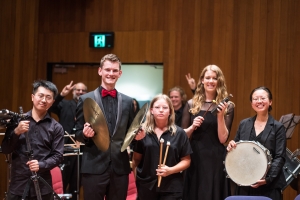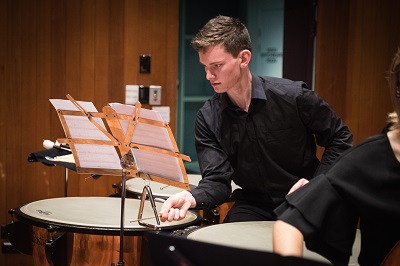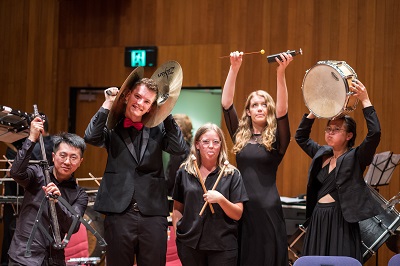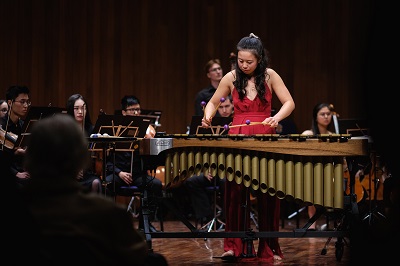So, You're A Percussionist?

There are over 100 students, staff and community members in our Large Instrumental Music Ensembles at any given time. Each month we will be introducing you to a new section of our ensembles.
Both the UNSW Orchestra and UNSW Wind Symphony have a team of keen percussionists. As well as playing many and varied instruments, they are also tasked with unpacking many large instruments (including 4 large timpani) before rehearsal and packing it all away again at the end of the evening.
UNSW Orchestra, Percussion Section Leader: Alice Hu is studying a combined Bachelor of Music with Honours and Bachelor of Science. She is in her 6th year at UNSW and has been playing with both UNSW Orchestra and UNSW Wind Symphony for 6 years. During her time at UNSW she has been on 2 international exchanges (University of Michigan and National University of Singapore) and was lucky enough to play with the Percussion departments there, too!
UNSW Wind Symphony Percussion Section Leader: Ollie Malnic is currently studying a combined Bachelor of Arts and Bachelor of Engineering and is in his 3rd year. Ollie has spent 3 years in both UNSW Wind Symphony and UNSW Orchestra. The most notable thing about him is that he is quite tall (191cm, or about 6”3.5’)!
 What is your favourite percussion instrument?
What is your favourite percussion instrument?
Alice: I'm going to go with what is my favourite to play in the ensembles, which is the Vibraslap! Look it up! It always gets heads turning when I play it in the Wind Symphony and has such an interesting tone colour and technique (slap with hand).
Ollie: My favourite percussion instrument is a dead tie between the triangle and the tubular bells.
For the triangle, I think there’s something very enchanting about its shimmering, metallic ring and how it can punctuate the entire sound of an orchestra to deliver such a delicate sound.
As for the tubular bells, I think their role as the deepest, most resonant instrument in the mallet family give it a very sonorous quality that really enhances the quality of a work, particularly when it’s bass-driven notes decay into the distance and leaving you to ponder on the deeper, more profound feeling of the piece.
What is the role of the percussion section in your ensemble?
Alice: The percussion section is like the icing and decoration on the cake - we provide a rhythmic backing that helps glue the ensemble together and bring interesting tone colours that add beauty and character to the music. We have to listen closely to the ensemble and watch the conductor to ensure that we properly compliment the sounds of the other musicians.
Ollie: Within the Wind Symphony, I think that the dominant role of percussion is to establish rhythm in the ensemble, but also to accentuate the rest of the ensemble with all the many textures and sounds that percussion instruments can create (think wind chimes, woodblock, whip, glockenspiel, etc.). The fun involved in playing these wacky instruments is easily one of the biggest highlights of playing in percussion.
What sets percussionists apart from other musicians?
Alice: Percussionists are expected to play many different instruments and I often describe it as 'the art of hitting things'. From mallets and timpani to snare drum and auxiliary percussion, these instruments have vastly different techniques and so we are constantly changing what we play according to the repertoire.
My role as section leader is to work collaboratively with the other percussionists to bring the music to life. This involves having conversations and making decisions about how to allocate parts to my section, what the best instrument set up is and how to interpret the sheet music. We work closely together as a team and are constantly adapting to the situation!
Ollie: As a percussionist, I feel that our section is dependent upon teamwork much more than other sections in the Wind Symphony. Playing repertoire in percussion also means juggling tasks such as assigning parts to members, arranging instruments and moving between instruments, so I think it’s really important to have good communication with the rest of your section.
Aside from that, I think there’s plenty to say about how much fun you can have trying new instruments/parts out, so I definitely recommend coming to try it out!
 If someone is keen to join the percussion section, what should they know?
If someone is keen to join the percussion section, what should they know?
Alice: We will welcome you with open arms! We love having new members of the percussion family and are keen to support you. Bring your can-do attitude, your excitement for hitting stuff and get ready to make some music!
Ollie: To anyone joining the percussion section, I would definitely highlight how many to opportunities are available to play both familiar and new instruments and repertoire. One of the core highlights of my time in percussion has definitely been the chance to play so many different instruments alongside my team, and I think it really adds to the sense of purpose that playing in the section creates.
